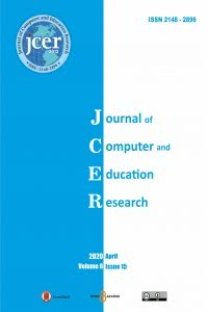Matematiksel Modelleme Problemlerinin Yapılandırılması Üzerine Tasarım Tabanlı İnceleme: Finansal İçerik Örneği
Tasarım araştırması, matematiksel modelleme, finansal okuryazarlık
Design based Investigation on Construction of Mathematical Modelling Problems: Example of Financial Content
___
- Aztekin, S. & Şener, Z.T. (2015). The content Analysis of Mathematical Modelling Studies in Turkey: A Meta-synthesis Study. Education and Science, 40 (178) Bernheim, D., Garrettand D., & Maki D., (2001). Education and saving: The long-term effects of high school financial curriculum mandates. Journal of Public Economics, 85, 435-565. Berry, J. & Houston, K. (1995) Students Using Posters as a Means of Communication and Assessment. Educational Studies in Mathematics, 29, (1), 21-27 Published by: Springer Stable URL: http://www.jstor.org/stable/3482829 . Blomhøj, M. & Jensen, T. H. (2003). Developing mathematical modelling competence: conceptual clarification and educational planning. Teaching Mathematics and Its Applications , 22(3), 123-139 Carlson, M., Larsen, S., & Lesh, R. (2003). Integrating models and modeling perspective with existing research and practice. In R. Lesh & H. M. Doerr (Eds.), Beyond constructivism: Models and modelling perspective on mathematics problem solving, learning, and teaching (pp. 465-478). Mahwah, NJ: Lawrence Erlbaum. Cobb, P., Confrey, J., diSessa, A., Lehrer, R. ve Schauble, L. (2003). Design experiments in educational research. Educational Researcher, 32(1), 9–13. Cobb, P., Confrey, J., diSessa, A., Lehrer, R. ve Schauble, L. (2003). Design experiments in educational research. Educational Researcher, 32(1), 9–13. Cole, S., T. & Sampsonand B. Z. (2011). Pricesor knowledge? What drives demand for financial services in emerging markets?. The Journal of Finance, 66 (6),1933-1967. Creswell, J. W. (2003). Research design: qualitative, quantitative, and mixed method approaches. Thousand Oaks, Calif, Sage Publications. Crouch, R., & Haines, C. (2004). Mathematical modelling: Transitions between the real world and mathematical model. International Journal of Mathematical Education in Science and Technology , 35(2), 197-206. Gravemeijer, K. (1999). Emergent Models May Foster the Constitution of Formal Mathematics. Mathematical Thinking and Learning, 1(2), 155-177. Greer, B. (1993). The mathematical modelling perspective on world problems. Journal of Mathematical Behaviour, 12, 239-250. Haines, C. & Crouch, R. (2001). Recognising constructs within mathematical modelling. Teaching Mathematics and its Applications, 20 (3): 129-138. Haines, C., Crouch, R., & Davis, J. (2000). Mathematical modelling skills: A research instrument (Technical Report No. 55). Hatfield, UK: University of Hertfordshire, Department of Mathematics INFE. (2009). Financial education programmes in schools: draft comparative analysis of selected financial education learning frameworks: international network on financial education. Jensen, T. H. (2007). Assessing Mathematical Modelling Competency. In C. Haines, P. Galbraith, W. Blum and S. Khan (Eds.), Mathematical Modelling Education, Engineering and Economics (ICTMA12). pp. 141-148. Chichester: Horwood. Kuzu, A.,Çankaya, S., Mısırlı, Z. A. (2011).Tasarım Tabanlı Araştırma ve Öğrenme Ortamlarının Tasarımı ve Geliştirilmesinde Kullanımı. Anadolu Journal of Educational Sciences International, July 2011, 1(1) Lawshe, C. H. (1975). A quantitative approach to content validity. Personnel Psychology, 28, 563–575. Lesh , R.A., & Doerr, H. (2003). Foundations of model and modeling perspectives on mathematic teaching and learning. In R.A. Lesh and H. Doerr (Eds.), Beyond constructivism: A models and modeling perspectives on mathematics teaching, learning, and problem solving. Mahwah, NJ: Lawrance Erlbaum. Lusardi, A. (2009), U.S. Household savings behavior: the role of financial literacy, information and financial education programs, InC. Foote, L. Goetteand S. Meier (eds.), Policy making Insights from Behavioral Economics, Federal Reserve Bank of Boston, pp. 109-149. Milli Eğitim Bakanlığı. (2009). İlköğretim matematik dersi 6-8. sınıflar öğretim programı ve kılavuzu, Ankara: Yazar. Merriam, S. B. (1998). Qualitative Researchand Case Study Applications in Education (second edition). San Francisco: Jossey-BassPublishers Miles MB, Huberman M. (1994).Qualitative Data Analysis: A Sourcebook of New Methods. 2. Beverly Hills, CA: Sage Publications Niss, M. & Jensen, T. H. (eds) (2002). Kompetencer og matematiklæring – Ideer og inspiration til udvikling af matematikundervisning i Danmark, number 18 in Uddannelsesstyrelsens temahæfteserie, The Ministry of Education, Copenhagen, Denmark. Cf. http://nyfaglighed.emu.dk/kom. OECD, (2005). Improving Financial Literacy Analysis of Issue and Policies. OECD, (2012). Guidelines on financial education at school and guidance on learning framework. Schoenfeld, A. H. (1982). Some thoughts on problem-solving research and mathematics education. In F. K. Lester And J. Garofalo (Eds.) Mathematical problem solving: issues in research (Pp. 27-37). Philadelphia: Franklin Institute Press. Veneziano L. ve Hooper J. (1997). A method for quantifying content validity of health-related questionnaires. American Journal of Health Behavior, 21(1):67-70. Wang, F. & Hannafin, M. (2005). Design-based research and technology-enhanced learning environments. Educational Technology Research and Development, 53(4), 5-23. Wang, F. ve Hannafin, M.J. (2005). Design-based research and technology-enhanced learning environments. Educational Technology Research and Development, 53(4), 5-23. Yurdugül, H. (2005). Ölçek Geliştirme Çalışmalarında Kapsam Geçerliği İçin Kapsam Geçerlik İndekslerinin Kullanılması XIV. Eğitim Bilimleri Kurultayı, 28-30 Eylül, Pamukkale Üniversitesi, Denizli Zbiek, R. M. & Conner, A. (2006). Beyond Motivation: Exploring mathematical modelling as a context for deepening students’ understandings of curricular mathematics. Educational Studies in Mathematics, 63, 89–112.
- Yayın Aralığı: 2
- Başlangıç: 2013
- Yayıncı: Tamer KUTLUCA
Üzeyir BEKERECİ, Mustafa YAZICI
Looking for a Black Cat: EFL Teachers’ Perception of Democracy
Computational Analysis of Igbo Numerals in a Number-to-text Conversion System
Zeki APAYDIN, Mehmet Ali KANDEMİR
Fatih ULUKAYA, Nail YILDIRIM, Vildan ÖZEKE
Fen Bilimleri Öğretmen Adaylarının Öğrenme Stillerinin Çeşitli Değişkenlerle İncelenmesi
